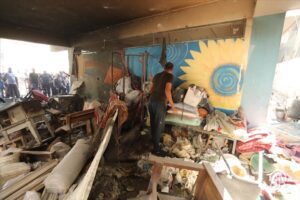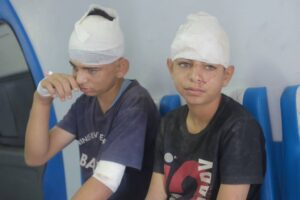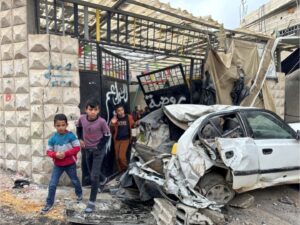The most precarious place in the world to be a child: Israel’s year of war on children
Israel’s onslaught against the Palestinian people has systematically targeted children in both Gaza and the West Bank. The result is a war against an entire generation.
By Tareq S. Hajjaj and Qassam Muaddi, reposted from Mondoweiss
A year into the genocide in Gaza and the intensifying military and settler onslaught in the West Bank, children have been the most consistently targeted group by Israel in all of historic Palestine.
Every year at around this time, the new school year is well underway in the Gaza Strip and university students are starting their first semesters. But since October of last year, not only is there no more school, but all education in the Gaza Strip has been decimated.
This is to say nothing of the systematic killing of children throughout the war — UN chief Antonio Guterres said Gaza had become a “graveyard for children” only a month into the genocidal war. Added to that are the long-term mental and health effects children will experience as a result of exposure to disease, chronic malnutrition, and relentless violence.
While paling in comparison to Gaza, children in the West Bank have also been targeted by Israeli forces and settlers with alarming regularity. Since October 7, the killing and maiming of Palestinian children by Israeli forces and settlers has skyrocketed according to human rights groups, leading to the deaths of at least 140 Palestinian minors under the age of 18 in the space of 11 months — at a rate of one child killed every other day.
While the effects of Israel’s war in Gaza have understandably garnered the most global attention, the Israeli violations against Palestinian childhood in both the West Bank and Gaza have made it clear that Israel has launched a war against an entire generation across Palestine.

Childhood under the gun in Gaza
On July 29, the Gaza-based Ministry of Education announced that 39,000 high school students from the Gaza Strip did not take the Tawjihi exam this year, with 10,000 of them killed alongside 400 school teachers.
The Government Media Office said that since the beginning of the war on Gaza, the Israeli army had completely destroyed 125 schools and universities and partially destroyed 336 schools and universities.
The assault on education is mirrored in the genocidal onslaught on all other sectors that make society in Gaza function, from healthcare to food systems to waste management facilities. But one of the most insidious parts of targeting the educational sector is that it aims to erase children’s future.
Sharif Alaa is one of many students originally from al-Shuja’iyya in Gaza City who are now living in the Mawasi “safe zone” in Khan Younis after seven rounds of displacement. At around this time last year in his old neighborhood in Gaza, he was starting his last year of high school and looking forward to applying to university the following year.
Sharif studied well throughout the past year, even amid the genocide, in order to get a high score that would enable him to specialize in the sciences. Sharif clung to his dream even when it seemed impossible given the circumstances, continuing to study throughout his multiple displacements. He held onto hope that at least some students would be allowed to take the exams in certain areas declared “safe” in Gaza.
But he never saw the inside of an exam hall. He listened to the annual radio announcements over the summer with great pain as the high school tawjihi results excluded the Gaza Strip for the first time in their history. Instead of announcing the results of the students who passed, the Gaza Ministry of Education announced the number of martyred students and teachers in the Gaza Strip.
“They destroyed my future without even harming me physically. So what about those who are injured? I feel indescribable pain because I lost my future. I was waiting to enter a new chapter of my life, and now it’s gone,” Sharif told Mondoweiss.
Ironically, Sharif spent much of his time in school compounds that had been converted into shelters throughout the war, first in northern Gaza, then in the south.
“Schools have lost their value as a place of education,” Sharif said. “They’ve become a place of displacement and loss of home and security.”
“These chairs, these tables, they were used for learning,” Sharif went one. “The school’s mornings were filled with national anthems…Now, classrooms are used as bedrooms housing several families, and people light wood in them to cook their food. This is no longer a school.”
On August 1, UNRWA launched an educational program for children to make up for parts of the school year they had missed. At the very least, it aimed to provide a safe space for children to play, learn, grow, and reunite with old friends.
“In its first phase, UNRWA will expand the ongoing psychosocial support activities, focusing on arts, music, and sports — as well as raising awareness on the risks of explosive ordinance,” UNRWA said in a press release.
“Children in Gaza are traumatized and shocked,” Scott Anderson, UNRWA Director in Gaza, said in the statement. “We are launching the back to learning program today to help children cope and just be children.”

Precarious childhood in the West Bank
In the West Bank, the conditions of Palestinian children’s safety have been deteriorating even a full year before October 7. But as of the start of the war last year, these conditions have plummeted.
According to a study published by Defense for Children International-Palestine (DCIP) on September 9, Israeli forces or settlers killed at least 140 Palestinian minors under the age of 18 in the space of 11 months — at a rate of one child killed every two days.
The latest of these victims was Bana Baker Laboum, 13, killed on September 6 during an attack by Israeli settlers on her village of Qaryout, southeast of Nablus. She was killed two days before the beginning of the school year.
According to testimonies by her family and residents, Bana was in her bedroom when Israeli settlers rampaged through the southern part of the village, opening fire on Palestinian houses.
One of the bullets hit her in the chest. She was hospitalized at the Rafidia Hospital in Nablus, where she was later pronounced dead.
At Bana’s school in Qaryout, a portrait of her in the middle of a wreath of flowers filled her place on her classroom bench.
Her classmate described Bana as “a very kind heart, always ready to comfort those who cried when seeing images of people suffering in Gaza.”
Speaking to the local Palestinian Fajer TV amidst tears, Bana’s classmate said that “she was in her room preparing her books, and she had planned to go out later that day to buy more things for the beginning of school.”
Her English language teacher and supervisor of the school’s girl scout group, described her as “a very polite, joyful, and bookish girl.” Her father, Amjad Baker Laboum, told Palestine TV that “I look at her classmates and I see Bana in each one of them.”
![Students enter their tent school, in which their teacher Alaa Abu Mustafa, whose house was destroyed in the Israeli army’s attacks, gives them education in Khan Yunis, Gaza on September 03, 2024. [ Hani Alshaer – Anadolu Agency]](https://israelpalestinenews.org/wp-content/uploads/2024/09/9-10-a-300x200.jpg)
Children targeted before October 7
While children in the Gaza Strip are forced to miss the beginning of the school year for the second time since the war began, the return to classes in the West Bank has been marked by increasing insecurity and fear as of two years ago, especially in areas most targeted by Israeli violence.
Already in December 2023, UNICEF reported that the killing of Palestinian children in the West Bank, including east Jerusalem, had reached “unprecedented levels.” In the last 12 weeks of 2023, Israel had already killed 83 Palestinian children in the West Bank, more than double the number of children killed in all of 2022, which was already considered one of the deadliest years for Palestinian children. More than 576 children had been injured in the same period.
“Living with a near-constant feeling of fear and grief is, sadly, all too common for children affected,” UNICEF stated. “Many children report that fear has become a part of their daily life, with many scared even walking to school or playing outside due to the threat of shootings.”
Since the beginning of 2024, the killing and maiming of children has only increased with each new Israeli military campaign.
In the latest major Israeli assault on West Bank cities, dubbed “Operation Summer Camps” in late August, Israeli forces killed 11 children and minors, aged between 13 and 17. Most of them were from Tulkarem, Tubas, and Jenin, where the heaviest part of Israel’s military operations in the West Bank have been concentrated as of October of last year.
“Israeli forces are killing Palestinian children with calculated brutality and cruelty all throughout the occupied Palestinian territory,” DCIP director Khaled Quzmar said in a statement.

Said Abu Eqtaish, also from DCIP, said that “not a single person has been held accountable for the killing of these children, emboldening Israeli forces to continue killing with impunity.”
Death and maiming is only the most visible part of the impact of Israeli violence on Palestinian children in the West Bank.
“Children’s school performance has dropped dramatically, as many of them haven’t been going to school regularly because of the repeated raids,” Nehaya al-Jundi, a mother and director of the handicapped children rehabilitation center in Nur Shams refugee camp, told Mondoweiss.
“Many suffer from distraction, uncontrolled fear, and involuntary urination, and for the mentally handicapped ones it is harder, because they don’t understand what happens around them.”
Nur Shams has been one of the hardest-hit areas in Israel’s relentless military campaign last August, which caused the widespread destruction of the camp’s civilian infrastructure.
“My daughter understands what happens in the camp, which makes it difficult to protect her from the reality,” Al-Jundi said. “Although she adapts and understands, she can’t hide her fear, which is constant.”
“For us mothers, it is difficult to protect our children from the trauma, because we are traumatized ourselves,” she added. “The most difficult trauma for children is the lack of safety, including inside their homes, as many of them have witnessed raids to their homes, and the arrest, and even the killing, of family members.”
As Israel’s crackdown on Palestinians in the West Bank continues to escalate amid expectations of a repeat of the “Gaza model,” Palestinian children continue to be the most vulnerable sector to Israeli violence, bearing the heaviest part of its impact. According to the DCIP report, a full 20% of children killed in the West Bank between 2000 and 2024 were slain after October 7.
Meanwhile, Palestinian children in the Gaza Strip continue to be killed on a daily basis, and the massacres show no sign of stopping. Those who survive are deprived of education, exposed to diseases and starvation, orphaned with no surviving parents, and traumatized.
The result has been a year of war against children that has made Palestine the most precarious place in the world to be a child.
Tareq S. Hajjaj is the Mondoweiss Gaza Correspondent, and a member of the Palestinian Writers Union. He studied English Literature at Al-Azhar University in Gaza. He has reported for Elbadi, Middle East Eye, and Al Monitor. Follow him on Twitter at @Tareqshajjaj.
Qassam Muaddi is the Palestine Staff Writer for Mondoweiss. Follow him on Twitter/X at @QassaMMuaddi.
RELATED READING:
- I’m a pediatrician. The scars I saw on Gaza’s children will take generations to heal.
- ‘Disappeared, buried, detained’: The horrors of Gaza’s missing children
- ‘Suffering horrifically’: 10 months of Israel’s ‘war on children’ in Gaza
- More dead children. More BBC ‘news’ channelling Israeli propaganda as its own


No comments:
Post a Comment